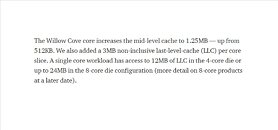Monday, September 14th 2020

Intel Confirms Development of 8-core Tiger Lake-H Processors
Intel's Corporate Vice President of Client Computing Group Boyd Phelps posted an article on medium where he confirms development of 8-core Tiger Lake-based CPU solutions, to be released during the year 2021. This was confirmed by Boyd saying that 8-core Tiger Lake CPUs would have access to 24 MB of LLC cache (adequately doubling the 12 MB available for 4-core Tiger Lake-U parts that we already know about); Boyd then simply added in parentheticals "more detail on 8-core products at a later date".
The 8-core processors will be part of the Tiger Lake-H product stack, which, according to a leaker on PTT Shopping, would scale between the 35 W-45 W TDPs with various core and GPU Execution Unit counts. The 45 W high-performance parts can feature between 4, 6, and 8-cores - but additional space taken up by the CPU cores is thus unavailable for GPU resources, which top out at 32 Intel Xe EUs (and will make use of a BGA1787 socket). The 35 W variants, on the other hand, will be installed in the same socket as Tiger Lake-U - BGA 1449 - and reportedly only offer a 4-core design with 96 EUs.
Sources:
Medium, PTTweb.cc, via Videocardz
The 8-core processors will be part of the Tiger Lake-H product stack, which, according to a leaker on PTT Shopping, would scale between the 35 W-45 W TDPs with various core and GPU Execution Unit counts. The 45 W high-performance parts can feature between 4, 6, and 8-cores - but additional space taken up by the CPU cores is thus unavailable for GPU resources, which top out at 32 Intel Xe EUs (and will make use of a BGA1787 socket). The 35 W variants, on the other hand, will be installed in the same socket as Tiger Lake-U - BGA 1449 - and reportedly only offer a 4-core design with 96 EUs.


9 Comments on Intel Confirms Development of 8-core Tiger Lake-H Processors
If this is true, I think it just tells me either that (1) Intel's 10nm is not as dense/efficient such that they cannot fit a higher end Xe graphics on anything more than 4 cores (die space or power constraints), and/or, (2) the Xe graphics simply takes up too much of the die space. I still feel that this supposed SuperFin is not as super as they claim since what I glean from the announcement is more power requirement, leading to higher clockspeed. I am still waiting for independent Tiger Lake reviews to appear. It feels like Intel went code silent after the release of Tiger Lake announcements. In contrast to AMD's Renoir where they managed to fit in 8 cores, while dropping from 10 CUs to 8CUs. It is not an apple to apple comparison, but just an indication.
/s